 Submitted by LOGOS - Overseer on
Submitted by LOGOS - Overseer on
Woodend, Australia's Hanging Rock (below) is a prehistoric volcanic outcrop that dominates the scenery. Some believe that it is a focal point for other-worldly forces and energies.
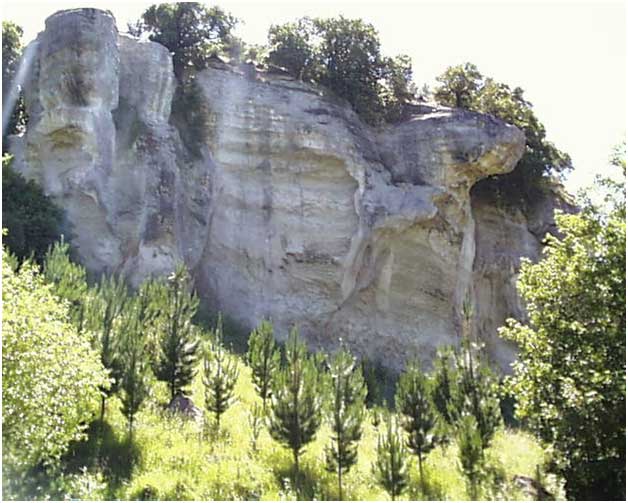
In 1967, a book titled Picnic at Hanging Rock authored by Lady Joan Lindsay portrayed the story of the strange disappearance of a group of teenaged schoolgirls and one of their teachers while on a school excursion on Valentine's Day in 1900. While hiking on the Rock, two of the girls and their teacher allegedly vanished into thin air while two of the girls that survived the ordeal had no memory of anything that had taken place. Facts supporting any real events regarding the disappearance are literally non-existent although Lady Lindsay while presenting the story as "fiction" evasively hinted that it was based upon true events.
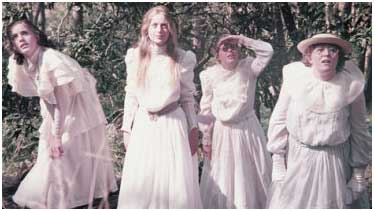
Clip from the movie Picnic At Hanging Rock
In the novel, 19 schoolgirls and two of their teachers, Mlle Diane de Poitiers and Greta McGraw of Appleyard College set out for a special picnic to celebrate St. Valentine's Day. Accompanying the group was a local coachmaster by the name of Ben Hussey. The only other party using the picnic grounds was encamped quite a distance away. It consisted of Colonel and Mrs. Fitzhubert, their visiting nephew Michael Fitzhubert and their groom Albert Crundall. They school group arrived at noon but shortly thereafter both Miss McGraw's and Ben Hussey's watches stopped which they attributed to the natural magnetism known to emanate from the Rock.
At 3:00 pm (a guesstimate made by Hussey by the Sun's placement in the afternoon sky), three of the senior girls, Irma Leopold, Marion Quade, and another girl known as Miranda asked for permission to explore the rock. A younger girl named Edith Horton was also given permission to join the others. They were all warned not to travel too far up the Rock and to be careful of their footing and of snakes and spiders. The four set out for the Rock and disappeared from sight of at around 3:30 pm. Michael Fitzhubert and Albert Crundall saw the girls cross a stream and then head up the Rock. Albert let out a wolf whistle and decided to follow the girls but he gave up after a few yards when the girls disappeared into a line of trees. In the meantime, the rest of the picnickers dozed off for a mid afternoon nap.
At around 4:30 pm, Mr. Hussey became anxious to gather all of the group together so he could get them back to the college at a reasonable time. It was then that he and Mlle de Poitiers discovered that Miss McGraw was also missing. After a quick canvassing of the group they learned that no one had seen Miss McGraw leave so it was assumed that she had at one point decided to join the other hikers on the Rock. Growing consternation led to the need for a search but no sign of the girls or their teacher could be found.
At around 5:30 pm Edith Horton stumbled out of the bush on the west side of the rock. She was screaming hysterically and could tell no one about anything that happened. As darkfall approached, everyone gave up the search and returned to the college. Mr. Hussey stopped at the Woodend police station and gave a statement to the constable.
The next a serious search for the missing students and their teacher was engaged. Among the local volunteers was Michael Fitzhubert and Albert Crundall. In the meantime, Edith Horton was examined by the local physician Dr. MacKenzie who felt she was suffering from a mild concussion along with some scratches and bruises. At first she remembered little about being on the Rock but a few days later she told the constable that she had passed Miss McGraw up on the Rock. She said that she called out to the teacher but that the teacher seemed not to hear her. She also said that Miss McGraw had no skirt on and was climbing the Rock in her under-drawers... hardly the proper attire for a prim Victorian lady. She also mentioned sighting a strange pink cloud hovering around the Rock at the same time she saw Miss McGraw.
Michael Fitzhubert and Albert Crundall fell under suspicion because they were the last two people to see the girls alive and they admitted to the police that they tried to follow them. The search continued for several days and the police brought in an Aboriginal tracker and a bloodhound. The dog was given the scent of Miss McGraw's clothing which he tracked up the rock. When the hound and trackers reached the a platform about half way up the dog stood bristling and growling refusing to move any further. The police then concluded that since so many days had passed the search was futile because no one could survive being in the bush that long. The search was called off.
At the end of the week, Michael and Albert decided to engage their own search for the girls. They found nothing but Michael decided to spend the night on the Rock. When Albert returned to find Michael the next morning he found him unconscious with a twisted ankle and suffering from exposure. Albert found a note in Michael's pocket with a largely incoherent scribbled message that suggested he had found something up on the Rock. The next day another search was made and to everyone's surprise Irma Leopold was found.
The girl was unconscious with several bruises and scratches on her head. Her fingernails were torn and broken. Most amazing of all her bare feet were perfectly clean and unmarked and although her corset was missing she had not been sexually assaulted. When she recovered she could remember nothing about the ordeal. Several months later the headmistress Mrs. Appleyard went out to Hanging Rock and climbed it alone. Her body was found at the edge of a precipice.
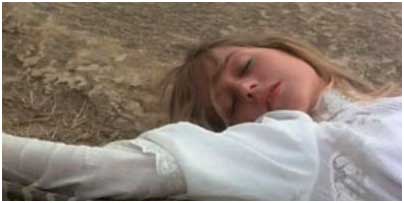
So what really happened at Hanging Rock? How much of Joan Lindsay's novel reflects a true incident? All of the locales mentioned in the story exist including a private girl's school in Woodend and a store run by the Hussey brothers. There was a real Dr. MacKenzie who practiced in the area at the turn of the century. There were however no references to the disappearances including any that would have been made in the local and Melbourne newspapers. The real girl's school called Clyde College did not open in Woodend until 1919. Alleged interviews given by Irma to the Society for Psychical Research cannot be traced and the newspaper that reported the interviews cannot be traced. Joan Lindsay remained enigmatic throughout all interviews and questioning regarding whether her novel was based on fact or fiction. She would merely smile and say, "It is an impossible question for me to answer. Fact and fiction are so closely intertwined."
For those of you who might be interested here is an astro-forensic chart cast for 3:00 pm for the locale reveals some uncanny and strange facets connected to the event.
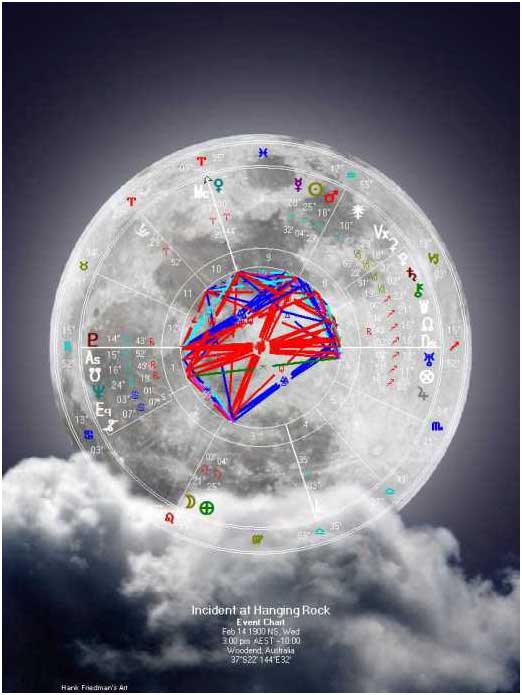
A quick look at the major angles reveals some interesting facts. The Ascendant is conjunct the Arabic Part of DANGER (15˚Gemini 52') indicating peril to the personal self and the Midheaven representing one's standing in the world is conjunct the Arabic Part of CATASTROPHE (2˚Aries 49'). The planet Uranus is conjunct the 7th house cusp representing "others" and the Arabic Part of BONDAGE (11˚Sagittarius 51').
All of the planets in the chart with the exception of Saturn in an Earth sign are in the elements of Fire and Air and some of those the Sun, Moon, Neptune and Chiron form a configuration known as the MYSTIC RECTANGLE. The Fire/Air emphasis represents masculine energy and great force coupled with cunning intelligence.
The planet Pluto is conjunct the Ascendant, the South Node in the 1st house and is opposed the Descendant, Uranus, and Jupiter in the 6th house. It is trine Mars in the 9th house and can be considered in a wide conjunction to Neptune in the 1st house. Pluto aspects represent a situation of ruthless force affecting destiny with a supernatural twist. Its opposition to the Descendant indicates conflict and struggle with others and the oppositions to Jupiter and Uranus indicate forced indoctrination, upheaval and violence. The fact that Uranus is angular conjuncting the 7th house cusp also points to "others" who have technical knowledge that goes above and beyond. The Plutonian conjunction to the South Node and Neptune indicate victims of circumstance who are not in control of destiny. The trine to Mars in the 9th house indicates strangers from foreign places with well developed willpower and the ability to "recharge" through use of energy.
Neptune in the 1st house always tends to exert strange, nebulous and confusing energy. It rules disappearances and it would be very representative of the "strange pink cloud" seen by Edith Horton as well as the lack of any traces of the girls and their teacher. It is opposed Saturn and Chiron in the 7th house indicating tremendous anxiety and fear and victimization by something or someone cunning and very much "in charge." It also trines a stellium in the 9th house consisting of the Sun, Mercury and Mars while sextiling the Moon in the 3rd house. This represents a transcendental situation where the ability to infiltrate and outmaneuver the minds of others is prevalent. Saturn receives a square aspect from Venus in the 9th house indicating that the situation was at best anti-social but more likely harsh. Along with its participation in the Mystic Rectangle the Moon also opposes Mercury and Mars and sesquiquadrates the Midheaven indicating distortion, dissipation, and jeopardy. The degree of this Moon according to astrologer Ada Muir represents one who can be "bound by lower astral forces."
A summary rehash of the astro events point most strongly to an "alien abduction."
The overall theme of the chart expresses a nebulous extraordinary or supernatural event laced with peril and bondage by “strangers” of unknown origin using force and mental cunning.
There are strong indications of a group of collective destiny affected by enforced indoctrination.
The use of advanced technical knowledge and mind control was prominent.
There were no traces of the girls or their teacher ever found.
WHAT DO YOU THINK?
POST SCRIPT : Picnic at Hanging is thought to be Joan Lindsey's best known work. It was made into a 1975 feature film by producers Patricia Lovell, Hal and Jim McElroy, and director Peter Weir. The story is fiction though Lindsey dropped hints that it was based on an actual event. An ending that explained the girl’s fate, in draft form, was excised by her publisher prior to publication. The final chapter was published in the 1980’s, in accordance with her wishes. Lindsey based Appleyard College, the setting for the novel, on the school she had attended Clyde Grammar School (Clyde School), at East Kilda, Melbourne – which, incidentally, in 1919 was transferred to Woodend, Victoria, in the immediate vicinity of Hanging Rock itself. There has been much speculation about what really happened in the story.
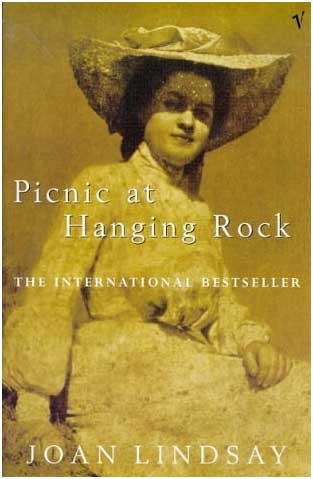
- 39842 reads